This repository contains an AI model and accompanying Python scripts for fully-automated simultaneous segmentation of 14 healthy organs with high tracer uptake onPET/CT images. The imaging tracer used in model development was [18F]DCFPyL.
Required model inputs: (a) DICOM PET series acquired with a PSMA tracer (tracers other than [18F]DCFPyL may work); (b) DICOM CT series The PET and CT inputs must be co-registered.
For details regarding model architecture, training methodology, and testing results please refer to the following publication: Klyuzhin IS, Chaussé G, Bloise I, et al. PSMA-Hornet: Fully-automated, multi-target segmentation of healthy organs in PSMA PET/CT images. Med Phys. 2024; 51: 1203–1216. https://doi.org/10.1002/mp.16658 PMID: 37544015
- Python 3.8+
- Python packages:
- tensorflow==2.3.1
- numpy
- pydicom
- glob2
- scipy
- rt_utils
- opencv-python
- You should be able to run the test inference script (main.py) from a native or virtual Python/Conda environment
- Ensure that
hornetlib.pyis included in your Python search path - Ensure that
unet2D_pretrain_inputfusion_vlarge_multioutput.200ep.fold0.h5is included in your Python search path
In the script main.py, set the variable INPUT_DIR to the folders where the PET and CT series are located
- Copy DICOM PET and CT series in the pre-specified directory
- Run
main.py
Note: Inference results will be saved as numpy ndarray in the variables
predicted_image(multi-channel) andpredicted_image_lab(single-channel). You will need to convert it to the desired format.
psma-hornet/
├── main.py # Python script for evaluating the model
├── hornetlib.py # Utility functions and architecture definitions
├── hornet_model.h5 # Model trained parameters
├── README.md # Project documentation
└── LICENSE # License fileThis project is licenced under the MIT License.
If you are including PSMA-Hornet into your projects, kindly include the following citation:
Klyuzhin IS, Chaussé G, Bloise I, et al. PSMA-Hornet: Fully-automated, multi-target segmentation of healthy organs in PSMA PET/CT images. Med Phys. 2024; 51: 1203–1216.
This project was supported by the Canadian Institutes of Health Research Project grant PJT-162216, National Institutes of Health / Canadian Institutes of Health Research QIN grant 137993, and Mitacs Accelerate grant IT18063. Azure Cloud compute credits were provided by Microsoft for Health.
